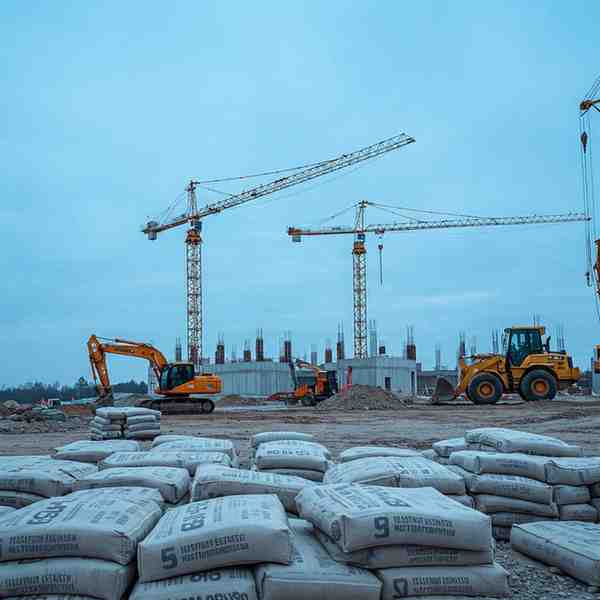
What’s in the Union Budget 2025 for Infrastructure and Cement?
What’s in the Union Budget 2025 for Infrastructure and Cement?
Increased Infrastructure Spending
The government has allocated substantial funds toward infrastructure development projects, including roads, railways, urban infrastructure, and affordable housing. This robust financial push is expected to create immediate and sustained demand for cement and other construction materials, driving sectoral growth.
Thank you for reading this post, don't forget to subscribe!Latest Update of Union Budget FY 2024-2025 for Infrastructure Sector:
- Central Government Infrastructure Investment: The Central Government has announced significant investments in infrastructure that have had a strong multiplier effect on the economy. Over the next five years, strong fiscal support for infrastructure has been planned. For capital expenditure this year, Rs. 11,11,111 crore has been allocated, constituting 3.40% of GDP.
- State Governments Infrastructure Investment: Based on their development priorities, similar scale support for infrastructure will be provided by the State Government. To support states in resource allocation, a provision of Rs. 1.5 lakh crore for long-term interest-free loans has been announced.
- Private Investment in Infrastructure: Through viability gap funding and enabling policies, private sector investment in infrastructure will be promoted. A market-based financing framework will be introduced.
- Pradhan Mantri Gram Sadak Yojana (PMGSY): Phase IV of PMGSY will be launched to provide all-weather connectivity to 25,000 rural habitations with increased populations.
Interest-Free Loans to States for Infrastructure Projects
To encourage state-level investments, the budget offers interest-free loans to states specifically for infrastructure development. This policy will likely accelerate the initiation of new projects and further fuel the demand for construction materials.
Emphasis on Affordable Housing
A key focus area of the budget is affordable housing, which will increase residential construction activity. This, in turn, will benefit cement companies by creating additional avenues for revenue.
Promotion of Public-Private Partnerships (PPPs)
The government’s push for PPPs aims to attract private investments, speed up project implementation, and ensure better resource allocation. This collaborative approach is expected to result in quicker execution of projects and heightened demand for construction materials.
Sustainability and Green Construction Initiatives
The budget also introduces several measures to promote environmentally friendly construction practices. As a result, the demand for eco-friendly cement and sustainable building materials is expected to rise, opening new opportunities for innovation in the sector.
Potential Challenges for Cement and Infrastructure Industries
While the Union Budget 2025-26 offers numerous growth opportunities, the industry faces certain challenges that could impact profitability and project execution.
Rising Competition
As demand for cement and infrastructure materials surges, competition among companies is expected to intensify. Firms must focus on innovation, efficiency, and effective project execution to maintain or expand their market share.
Volatility in Raw Material Prices
Fluctuations in the prices of key raw materials such as limestone, fuel, and coal can impact the profit margins of cement companies. Monitoring commodity prices and adopting cost-control measures will be essential to mitigating risks.
Timely Project Execution
For the budget’s positive impact to be fully realized, timely implementation of projects is crucial. Delays in project approvals or execution could result in slower demand growth for construction materials.
Why Cement Stocks in India Are a Strong Long-Term Investment
Cement stocks have long been considered a safe and stable investment, but the 2025-26 budget offers new catalysts for growth. Let’s explore the reasons why cement stocks present an attractive opportunity for long-term investors.
Continuous Infrastructure and Construction Needs
India’s ongoing development demands robust infrastructure expansion, including highways, railways, commercial buildings, and housing projects. This consistent need ensures sustained demand for cement.
Government Initiatives and Policies
Programs like “Housing for All” and the National Infrastructure Pipeline (NIP) underscore the government’s commitment to infrastructure development. These initiatives will serve as long-term growth drivers for the cement industry.
Rapid Urbanization
India’s rapid urbanization is driving demand for residential and commercial infrastructure in cities. With urban populations expanding, the need for housing, transportation, and utility infrastructure is on the rise, supporting long-term demand for construction materials.
Industry Consolidation and Efficiency
The consolidation of the Indian cement sector, with larger companies acquiring smaller ones, has improved overall operational efficiency. Economies of scale and streamlined production processes have contributed to the profitability of leading cement companies.
Resilient Demand Amid Economic Fluctuations
Unlike other sectors, demand for cement is relatively stable, as construction activities are less affected by short-term economic downturns. This resilience makes cement stocks an attractive option for long-term investors seeking stability.
Key Risks to Consider Before Investing in Cement Stocks
Investors should carefully evaluate the following risks before committing to cement stocks:
- Raw Material and Energy Costs: Fluctuations in the cost of inputs like limestone, coal, and energy can impact profit margins.
- Competition: With increasing demand, companies must continuously innovate to maintain their competitive edge.
- Government Regulations: Environmental and infrastructure-related policies can influence the profitability of cement firms.
Leading Cement Companies in India to Watch
Investors looking for exposure to this growth should consider top-performing cement stocks:
- UltraTech Cement
- Ambuja Cements
- ACC
- Shree Cement
- Dalmia Bharat
These companies have strong fundamentals, extensive operational footprints, and proven track records in navigating market fluctuations.
Why Infrastructure Stocks Hold Growth Potential in 2025
In addition to cement, infrastructure stocks are poised for growth due to key factors outlined in the 2025-26 budget:
Government Focus and Investment
The National Infrastructure Pipeline and increased budget allocation indicate strong government support for long-term infrastructure development. Additionally, favorable policy reforms will further boost investment and project execution.
Economic Growth and Urbanization
India’s expanding economy and rapid urbanization necessitate better infrastructure in transportation, energy, and utilities, creating numerous opportunities for infrastructure companies.
Technological Innovations
Adoption of advanced technologies like automation and data analytics is enhancing efficiency and cost control in infrastructure projects, making them more profitable and attractive to investors.
Conclusion
The Union Budget 2025-26 has laid a solid foundation for growth in the cement and infrastructure sectors, with increased government spending, policy support, and sustainability initiatives providing multiple catalysts for long-term expansion. While potential risks exist, companies that adapt to challenges and maintain operational efficiency are likely to thrive. For investors, cement and infrastructure stocks present a promising opportunity, but careful evaluation of company fundamentals, market conditions, and risks is essential. By taking a long-term view, investors can position themselves to benefit from India’s booming infrastructure landscape.
Related Blogs:
Best Cement Stocks in India
Top 5 Cement Stocks in India
Best Infrastructure Stocks in India
Top 5 Infrastructure Stocks to Buy in India in 2025
Top 5 Indian Railway Stocks in India
Disclaimer: This blog post is intended for informational purposes only and should not be considered financial advice. The financial data presented is subject to change over time, and the securities mentioned are examples only and do not constitute investment recommendations. Always conduct thorough research and consult with a qualified financial advisor before making any investment decisions.

